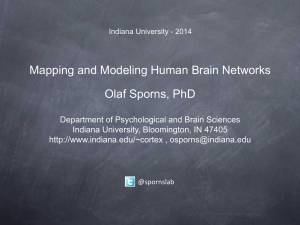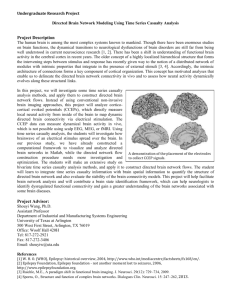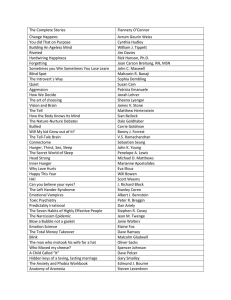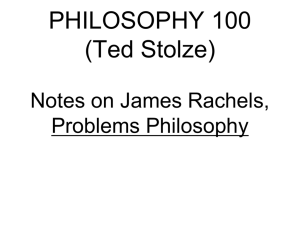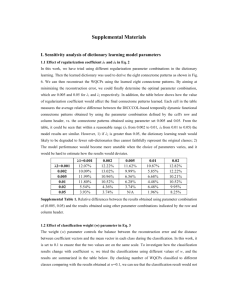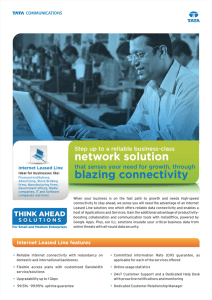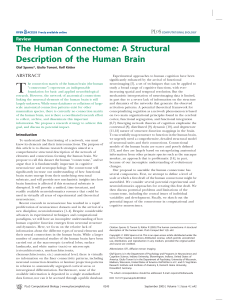Discovering the Human Connectome Olaf Sporns Networks and Complex Systems 2012 Outline
advertisement
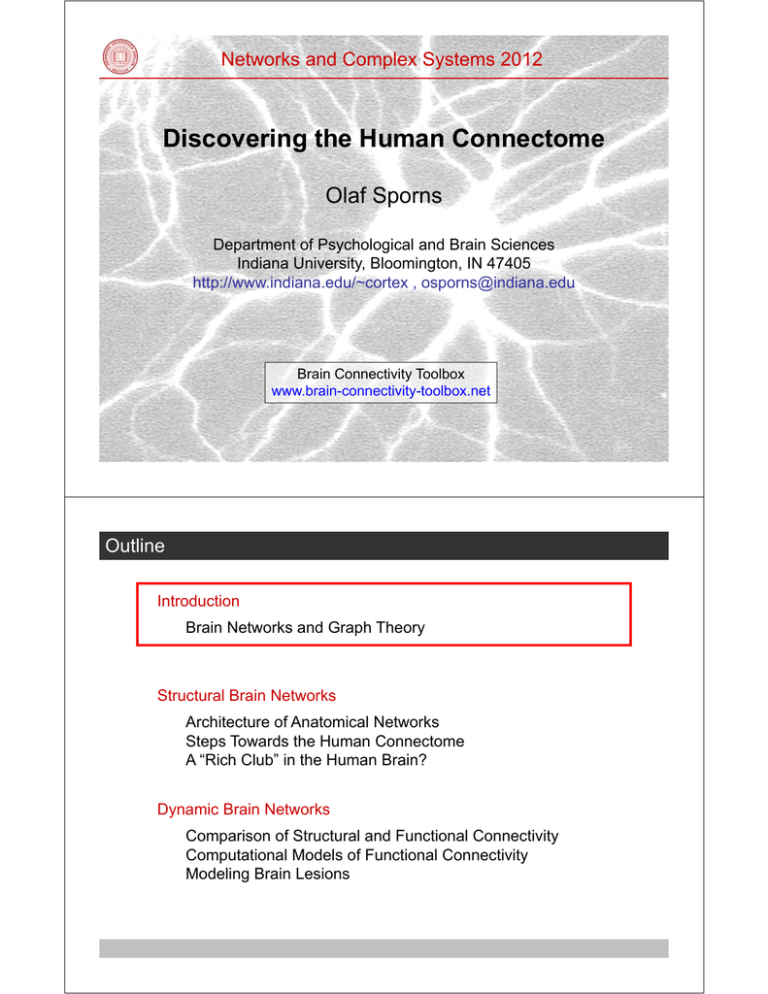
Networks and Complex Systems 2012 Discovering the Human Connectome Olaf Sporns Department of Psychological and Brain Sciences Indiana University, Bloomington, IN 47405 http://www.indiana.edu/~cortex , osporns@indiana.edu Brain Connectivity Toolbox www.brain-connectivity-toolbox.net Outline Introduction Brain Networks and Graph Theory Structural Brain Networks Architecture of Anatomical Networks Steps Towards the Human Connectome A “Rich Club” in the Human Brain? Dynamic Brain Networks Comparison of Structural and Functional Connectivity Computational Models of Functional Connectivity Modeling Brain Lesions Introduction Networks as Models of Complex Systems Citation patterns and scientific paradigms edges nodes US commuting pattern yeast interactome Vespignani (2009) Science 325, 425. Jeong et al. (2001) Nature 411, 41 Kevin Boyak, Dick Klavans, Bradford Paley Introduction The Brain – A Complex Network Ludwig Klingler - 1956 Patric Hagmann - 2008 Introduction Multiple Scales – Cells, Circuits, Systems Microscopic: Single neurons and their synaptic connections. Mesoscopic: Connections within and between microcolumns (minicolumns) or other types of local cell assemblies Macroscopic: Anatomically segregated brain regions and inter-regional pathways. Tamily A. Weissman (Harvard University) Patric Hagmann (EPFL/CHUV Lausanne) Introduction Multiple Modes – Structural, Functional, Effective Anatomical (Structural) Connectivity: Pattern of structural connections between neurons, neuronal populations, or brain regions. Functional Connectivity: Pattern of statistical dependencies (e.g. temporal correlations) between distinct (often remote) neuronal elements. Effective Connectivity: Network of causal effects, combination of functional connectivity and structural model. Patric Hagmann (EPFL/CHUV Lausanne) Achard et al. (2006) J. Neurosci. 26, 63 McIntosh et al. (1994) J. Neurosci. 14, 655 Introduction Extraction of Brain Networks from Empirical Data Bullmore & Sporns (2009) Nature Rev Neurosci 10, 186. Introduction Graph Theory: Basic Definitions Graph metrics capture various aspects of local and global connectivity: Segregation Clustering Motifs Modularity Integration Distance Path Length Efficiency Influence Degree Centrality (Hubs) www.brain-connectivity-toolbox.net Outline Introduction Brain Networks and Graph Theory Structural Brain Networks Architecture of Anatomical Networks Steps Towards the Human Connectome A “Rich Club” in the Human Brain? Dynamic Brain Networks Comparison of Structural and Functional Connectivity Computational Models of Functional Connectivity Modeling Brain Lesions Structural Brain Networks Anatomical Organization of Cerebral Cortex Principles of network architecture in cortex: Specialization Integration Streams (modules) Hierarchy Felleman and Van Essen (1991) Cerebral Cortex 1,1. Van Essen et al. (1992) Science 255, 419. Structural Brain Networks Modular Brain Networks Each functionally specialized cortical region has a unique connectional fingerprint – a unique set of inputs and outputs. Structural modules consist of nodes that have similar connections with other nodes. Structural modules reflect functional relationships. regions and interconnections of cat cerebral cortex Passingham et al. (2002) Nature Rev Neurosci 3, 606. Hilgetag et al. (2000) Phil. Trans. Royal Soc. B 355, 91 Structrual Brain Networks Modules in Mouse Cortex Analysis of axonal projections in flat-mounted mouse cortex using the anterograde tracer Biotinylated Dextran Amide (BDA) Flatmap representation Optical density Matrix (network) of projection weights Projections revealed by BDA injection into V1 Wang, Gao & Burkhalter (2011) J Neurosci 31,1905 Wang, Sporns & Burkhalter (2012) J Neurosci 32, 4386. Structural Brain Networks Modules in Mouse Cortex Network analysis of mouse visual cortical projections suggests the existence of analogues to primate ventral and dorsal streams. b m1 a m1 m2 m2 = strongest projection c m2 > m1 m1 > m2 Wang & Burkhalter (2011) J Neurosci. Wang, Sporns & Burkhalter (2012) J Neurosci 32, 4386. Structural Brain Networks The Human Connectome The connectome can be defined on multiple scales: Microscale (neurons, synapses) Macroscale (parcellated brain regions, voxels) Mesoscale (columns, minicolumns) Most feasible in humans, with present-day technology: macroscale, diffusion imaging → central aim of the NIH Human Connectome Project Other methodologies and systems: Mesoscale mapping of mouse brain connectivity (Bohland et al.) Microscale mapping of neural circuitry (Lichtman et al.) Serial EM reconstruction (Briggman and Denk) Sporns et al. (2005) PLoS Comput. Biol. 1, e42 Structural Brain Networks Mapping Human Brain Structural Connectivity A map of the world, 1572 A map of the connectome, 2008 Hagmann et al. (2008) PLoS Biol. 6, e159 Structural Brain Networks Mapping Human Brain Structural Connectivity Patric Hagmann Hagmann et al. (2008) PLoS Biol. 6, e159 Structural Brain Networks The Human Brain Network Analysis of the Connectome Network analysis revealed • • • • • Exponential (not scale-free) degree distribution Robust small-world attributes Several modules interlinked by hub regions Positive assortativity A prominent structural core core modules Hagmann et al. (2008) PLoS Biol. 6, e159 Structural Brain Networks The Human Brain Modules, Cores, and Rich Clubs In some networks, highly connected/central hub nodes have a tendency to be highly connected to each other (“rich-club” organization). Colizza et al. (2006) Nature Physics Bullmore and Sporns (2012) Nature Rev Neurosci Structural Brain Networks The Human Brain Rich-Club Organization of the Human Connectome Human connectome data sets exhibit a prominent rich club, comprising cortical and subcortical regions. Presence of rich-club (RC) organization suggests central role in information integration and communication. DTI study, 21 participants, low (82 nodes) and high-resolution (1170 nodes) partition, streamline tractography Colizza et al. (2006) Nature Physics Martijn van den Heuvel van den Heuvel and Sporns (2011) J. Neurosci. Structural Brain Networks The Human Brain Rich-Club Organization of the Human Connectome RC members include: precuneus, superior parietal and frontal cortex, insula, medial temporal regions Large proportion of short communication paths travel trough RC RC damage has disproportionate effects on network integrity Colizza et al. (2006) Nature Physics van den Heuvel and Sporns (2011) J. Neurosci. Structural Brain Networks The Human Brain Rich-Club Organization of the Human Connectome Replication Once the RC is identified, connections can be classified as RC, feeder, local. Van den Heuvel et al. (2012) PNAS Structural Brain Networks The Human Brain Rich-Club Organization of the Human Connectome RC connections are mainly long-distance, and thus represent a high-cost feature of cortical organization – they also account for a large share of short paths. Van den Heuvel et al. (2012) PNAS Structural Brain Networks Rich-Club Organization of the Human Connectome Hidden metric spaces enable “greedy routing” strategies in large communication networks (e.g. air travel) Short paths in human brain structural networks exhibit patterned degree sequences, with a central role of RC nodes and edges. Boguna et al. (2009) Nature Physics 5, 74. Van den Heuvel et al. (2012) Proc Natl Acad Sci USA Structural Brain Networks Rich-Club Organization of the Human Connectome RC is detected also in macaque cerebral cortex – with similar high-cost features and central involvement of the RC in short paths, and with degree-ordering suggestive of “greedy routing”. Harriger et al. (2012) PLoS ONE Outline Introduction Brain Networks and Graph Theory Structural Brain Networks Architecture of Anatomical Networks Steps Towards the Human Connectome A “Rich Club” in the Human Brain? Dynamic Brain Networks Comparison of Structural and Functional Connectivity Computational Models of Functional Connectivity Modeling Brain Lesions Dynamic Brain Networks A B Wiring and Dynamics – Complex Interrelations Structural connectivity is (relatively) stable across time. Functional connectivity is dynamic (endogenous/exogenous). How much of functional connectivity can be predicted from structural connectivity? What is the contribution of network theory and modeling in understanding the nature of brain dynamics? Hagmann et al. (2008) PLoS Biol. 6, e159 Movie: Vincent, Raichle et al. (Washington University) right hemisphere SC left hemisphere Data from Honey et al (2009) right hemisphere FC left hemisphere Data from Honey et al (2009) Dynamic Brain Networks Wiring and Dynamics – Human Brain DSI structural connections SC seeds placed in PCC, MPFC functional connectivity (rsFC) – nonlinear model modeling prediction comparison inference FC functional connectivity (rsFC) - empirical rs-fMRI functional connections Honey et al. (2009) PNAS 106, 2035. Dynamic Brain Networks Structural Relating and Functional Connectivity Direct Comparison of Structural and Functional Connections RH Thresholding rsFC does not allow the reliable inference of SC. Honey et al. (2009) PNAS 106, 2035. Sporns (2011) Ann NY Acad Sci 1224, 109. Dynamic Brain Networks Structural Relating and Functional Connectivity Direct Comparison of Structural and Functional Connections Where SC is present, its strength is partially predictive of the strength of rsFC on the same node pair. All Participants, All Areas The strength of the prediction ranges from R ≈ 0.50 (998 nodes; R ≈ 0.4-0.45 in single participants) to R ≈ 0.72 (66 nodes), and persists when physical distance between nodes is regressed out. Significant variance is unaccounted for by the strength of direct SC. Indirect SC improves prediction. Hagmann et al. (2008) PLoS Biol. 6, e159. Honey et al. (2009) PNAS 106, 2035. Dynamic Brain Networks Direct Comparison of Structural and Functional Connections The strength of the SC/rsFC relationship increases during development (ages 2-18 years) Hagmann et al. (2010) Proc. Natl. Acad. Sci USA 107, 19067. Dynamic Brain Networks Modeling Endogenous Brain Activity Connectivity + Dynamics = Endogenous Brain Activity Connection matrix of visual/sensorimotor macaque cortex + Dynamic equations describing the physiology of a neural population (neural mass) = Spontaneous (endogenous) neural dynamics (chaoticity, metastability) Honey et al. (2007) Proc. Natl. Acad. Sci. USA106, 2035. Dynamic Brain Networks Modeling Endogenous Brain Activity Functional brain networks (simulated BOLD fluctuations) reflect the network architecture of their underlying structural substrate (structural/functional modularity). Fast fluctuations in neural synchrony → slow fluctuations in neural population activity. simulated fMRI cross-correlations empirical structural correlations Honey et al. (2007) Proc. Natl. Acad. Sci. USA106, 2035. Dynamic Brain Networks Model Comparison with Macaque fMRI Central question: What determines the strength of FC, particularly across unconnected regions? Data: Recordings of BOLD-fMRI (anesthesia, 15 min runs, 26 runs, 3 sessions, 1 mm voxels) in 2 macaque monkeys, processed into standard cortical parcellation covering 39 areas. SC (AC): cocomac database of macaque cortical connections. Imaging reveals many instances of “indirect FC” Adachi et al. (2011) Cerebral Cortex Dynamic Brain Networks Model Comparison with Macaque fMRI Empirical and simulated FC are significantly correlated. Adachi et al. (2011) Cerebral Cortex Dynamic Brain Networks Model Comparison with Macaque fMRI On average FC on connected region pairs is higher (both empirically and modeled). On unconnected region pairs, the strength of FC is partially predicted by the number of paths of length 2 (indirect paths - both empirically and modeled). Adachi et al. (2011) Cerebral Cortex Dynamic Brain Networks Structural Relating and Functional Connectivity Model Comparison with Human MRI The relation between SC and rsFC is similar in strength for empirical data (left) and computational model (right). Note that the fully deterministic (nonlinear and chaotic) model does not yield a “simple” linear SC-rsFC relationship. Hagmann et al. (2008) PLoS Biol. 6, e159. Honey et al. (2009) PNAS 106, 2035. Dynamic Brain Networks Towards a Large-Scale Model of the Human Brain Model Comparison with Human MRI Structural connections of the human brain predict much of the pattern seen in resting state functional connectivity. structural connectivity (SC) functional connectivity (rsFC) - empirical functional connectivity (rsFC) – nonlinear model seeds placed in PCC, MPFC Honey et al. (2009) PNAS 106, 2035. Dynamic Brain Networks Modeling the Functional Impact of Lesions Lesions of structural brain networks result in system-wide functional disturbances. Models of endogenous fluctuations in neural activity can be used to estimate the functional impact of structural lesions. anterior cingulate Centrality of lesion site partially predicts lesion effects. + lesion site precuneus + Effects of lesions in anterior cingulate or precuneus (decreased FC = red, increased FC = blue) Alstott et al. (2009) PLoS Comput Biol 5, e1000408 Summary The brain is a complex network. Brain networks are organized on multiple scales, and shape patterns of neural dynamics. Network science offers a theoretical framework for the study of the nervous system. The connectome is a comprehensive description of brain connectivity – a foundational data set The connectome will inform the design of global computational models of the human brain. Further Reading and Acknowledgements Sporns O (2011) Networks of the Brain. MIT Press. Sporns O (2012) Discovering the Human Connectome. MIT Press. Lab: www.indiana.edu/~cortex NIH Human Connectome Project: www.humanconnectome.org The Virtual Brain Project: http://thevirtualbrain.org Network Analysis Toolbox (Matlab): www.brain‐connectivity‐toolbox.net Thank you Mika Rubinov, Patric Hagmann, Chris Honey, Rolf Kötter, Michael Breakspear, Jeff Alstott, Andreas Burkhalter, Yusuke Adachi, Yasushi Miyashita Ed Bullmore, Martijn van den Heuvel Funded by the James S. McDonnell Foundation, NIH Human Connectome Project
